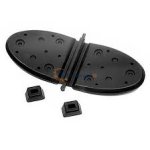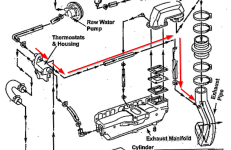Ricky_rich
Petty Officer 2nd Class
- Joined
- Mar 4, 2014
- Messages
- 149
I have a engine with the cooling system as in the picture.
A new exhaust manifold is installed, new impeller and new thermostat.
The engine it self is not running hot, only exhaust manifold getting to hot. I guess that affects carburetor and intake of gas/air, cause after running full throttle for a minute of two engine dies.
Have tried without thermostat but didn't help. I have a good flow of water from the raw water pump.
Is it possible that there could be something wrong between manifold and elbow that restricts water flow?

A new exhaust manifold is installed, new impeller and new thermostat.
The engine it self is not running hot, only exhaust manifold getting to hot. I guess that affects carburetor and intake of gas/air, cause after running full throttle for a minute of two engine dies.
Have tried without thermostat but didn't help. I have a good flow of water from the raw water pump.
Is it possible that there could be something wrong between manifold and elbow that restricts water flow?

























